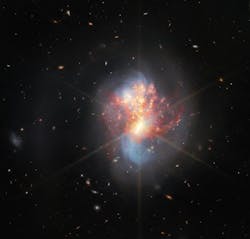Webb captures pair of merging galaxies
A new stunning image from the Webb Space Telescope shows an entwined pair of galaxies, IC 1623, which are about 270 million lightyears from Earth in the Cetus constellation.
These two galaxies are plunging into each other in a process known as galaxy merger. And this merger is igniting a frenzied spate of star formation known as a starburst—creating new stars at a rate more than 20x that of the Milky Way galaxy.
This interacting galaxy system is particularly bright at infrared (IR) wavelengths, according to the European Space Agency, making it an ideal proving ground for Webb’s ability to study luminous galaxies.
Astronomers captured IC 1623 across the IR portions of the electromagnetic spectrum using a trio of Webb’s cutting-edge scientific instruments—MIRI, NIRSpec, and NIRCam. An abundance of data will allow the astronomical community to explore how Webb can help unravel complex interactions within galactic ecosystems. These observations are also accompanied by data from other observatories, including NASA/ESA Hubble Space Telescope.
The merger of these two galaxies is of long-standing interest to astronomers, and was previously imaged by Hubble and other space telescopes. This ongoing extreme starburst causes intense IR emission, and the merging galaxies may be in the process of forming a supermassive black hole. Unfortunately, a thick band of dust blocked these valuable insights from the view of telescopes like Hubble. But Webb’s IR sensitivity and impressive resolution of at those wavelengths allows it to see beyond the dust and resulted in this spectacular image, which is a combination of MIRI and NIRCam imagery.
It turns out the luminous core of the galaxy merger is both very bright and highly compact, so Webb’s diffraction spikes appear atop the galaxy within this image: the eight-pronged, snowflake-like diffraction spikes are created by the interaction of starlight with the physical structure of the telescope. This spiky quality of Webb’s observations is particularly noticeable in images containing bright stars, such as Webb’s very first deep field image.
